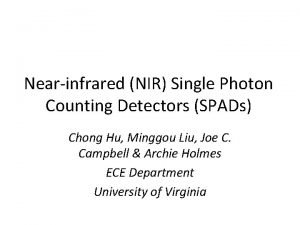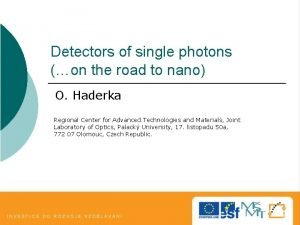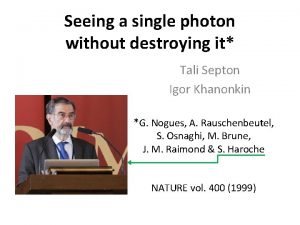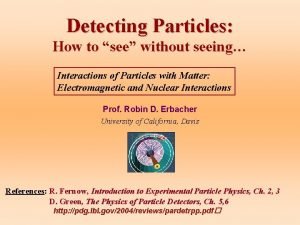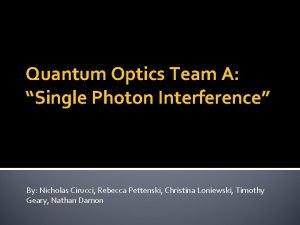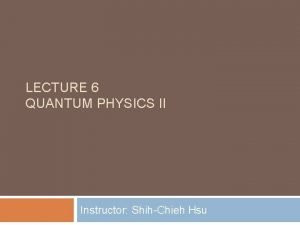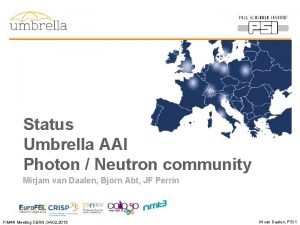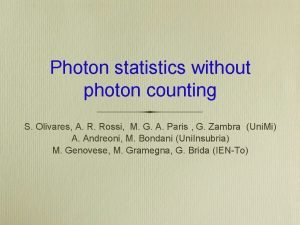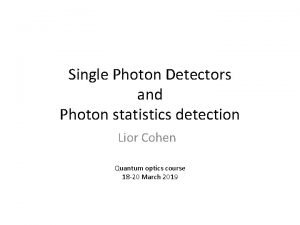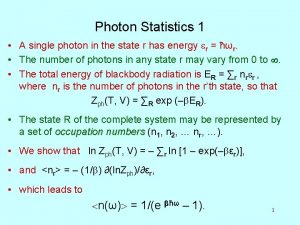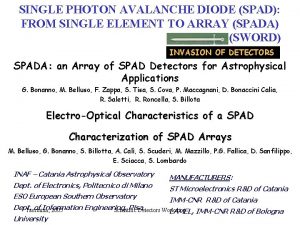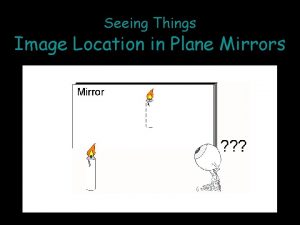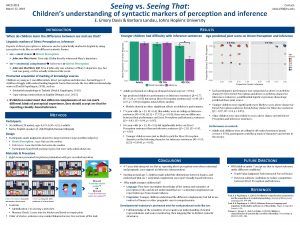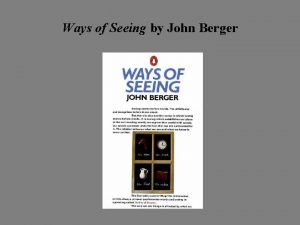Seeing a single photon without destroying it Tali












- Slides: 12

Seeing a single photon without destroying it* Tali Septon Igor Khanonkin *G. Nogues, A. Rauschenbeutel, S. Osnaghi, M. Brune, J. M. Raimond & S. Haroche NATURE vol. 400 (1999)

How do we see photons? • Opsins- light-sensitive proteins found in photoreceptor cells of the retina. • Photodiodes, photomultipliers, Pyroelectric photodetectors, Thermal detectors… ! n o i t a t i m i l l Seeing a photon = demolition of photon ? ta n e am d n u f a Not

Quantum non-demolition strategies “overcome the standard quantum limit in experimental detection of an observable” • Some degree of accuracy is required • Preservation of the physical integrity of the measured system • Repeated measurements should give the same result (no uncertainty back action) ton? only e v i t i s n Se copic s o r c a to m ph s, w e x u l f n oto hat a pho e l g n i s bout a

1 photon case: Atom e g Cavity t=0 |g>, v |1> t= w/v Rabi oscilations: cos(W t/2)|g, 1>+sin(W t/2)|e, 0> time of interaction: t=2 p/W (2 p Rabi pulse): exp(ip)|g, 1> ____________________________ 0 photon case: |g, 0> ____________________________ e Cavity g 0 photon case: Ci|i, 0>+Cg|g, 0> 1 photon case: i Ci|i, 1>+Cg|g, 1> Ci|i, 1>+Cg exp(ip)|g, 1>

SP-QND scheme Cavity 2 p |1> or |0> g e Field i (0. 5|g>+0. 5|i>) Field (n) p/2 (0. 5 exp(ip)|g>+0. 5|i>) Cavity no photon Ramsey fringes |g> “Meter” atom 1 photon

Set-up details To achieve strong matter radiation coupling we use: § Temperature ~1 K: • Rydberg atoms – long natural life-time(~30 ms) • High Q cavity- photon life-time (the same order of magnitude as atoms) Control mechanisms of the system: • Stark shift - tune tinteraction • Eraser pulses – cleaning the cavity before meas. 6

#1 Preparing and detecting one photon Detecting Source atom: |e> : no photons left in cavity |g> : 1 photon left in cavity Field (n) p/2 |e> |g> “Source” “Meter” . . . p/2 Rabi pulse 2 p Rabi pulse Field (n) p/2 e Cavity g Field i • The setup is characterized by well resolved Pa/1 and Pa/0 • In a practical measurement the photon number is initially unknown. • We are interested in the reverse probabilities P 1/a and P 0/a (0. 5 exp(i |g>+0. 5|i>) 0. 5|g, 1>p) + 0. 5|e, 0> (0. 5|g>+0. 5|i>) P 1=P 0=50%

#2 Measuring a photon twice • P 1, P 0: probabilities to have a photon (or not) in C before measurement. • Describes how the information acquired by the meter changes the probability of having 1 photon

#2 Measuring a photon twice Small thermal field P 1=0. 18; P 0=0. 77 2 p Rabi pulse Field (n) p/2 “Meter” Short delay in time “Probe” |g 2> • The information acquired about the field by the first measurement modifies the probability of finding a photon in C • When the meter finds 1 photon, it does so without destroying it. SP-QND Probability of finding 1 photon in C = Pe 2 Field (n) p/2

#3 Repeated single photon measurements Small thermal field P 1=0. 18 2 p Rabi pulse Short delay in time n p/2 “Meter” |g 1> “Meter” |g 2> n p/2 Finding second meter in the same state as the first is larger than the a priori probability At n 1: Pi 2/i 1=0. 48 Pi 1=0. 32 Ideally: Pi 1=0. 18; Pi 2/i 1=1. predicted by numerical model 10

Conclusion • Single photon QND measurements satisfy the criteria of: - Eigen values are well resolved - Non-demolition - Repeatability: photon number probability increases after meter reading

Thank you for your attention!

